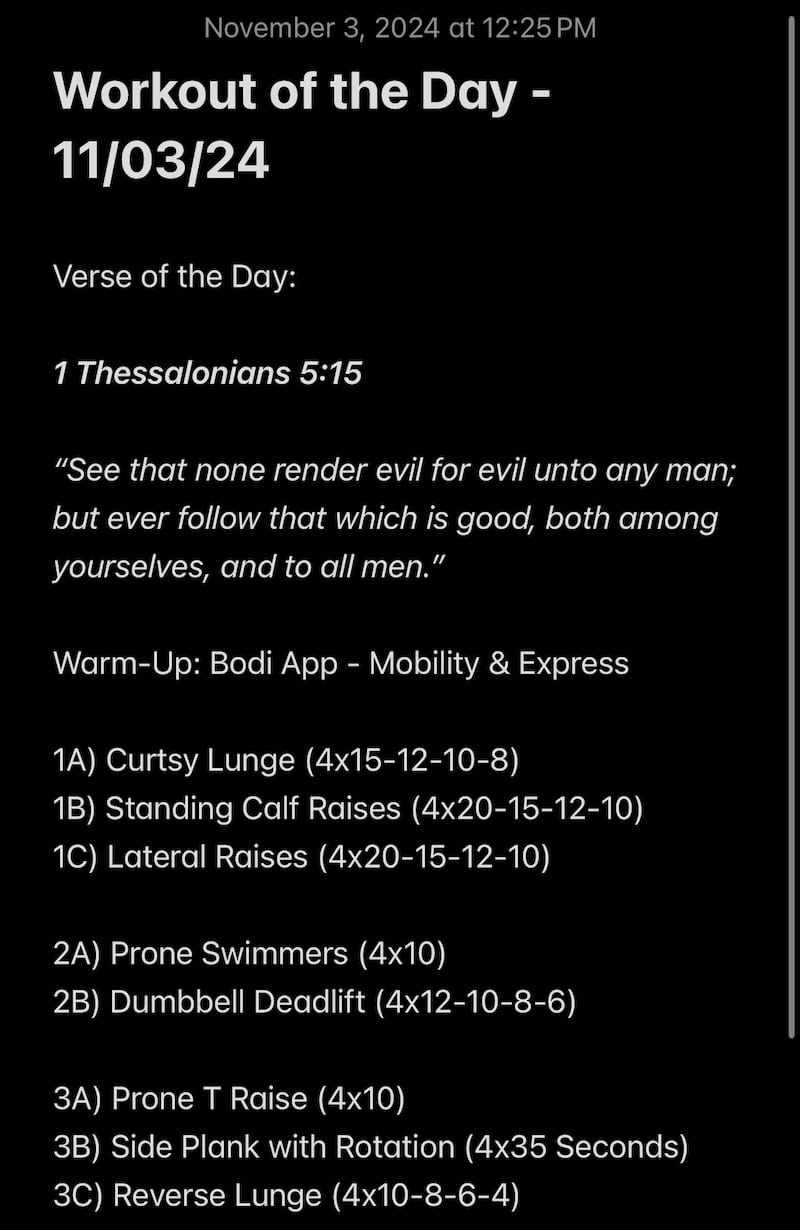11/03/2024 – Workout of the Day (Lower Body & Shoulders)
Today’s workout is built around exercises that promote both strength and stability, encouraging the body to move with control and alignment through each set. Guided by the message in 1 Thessalonians 5:15, this session reminds us of the importance of choosing positive actions in all aspects of life, even when faced with negativity.
As we move through each exercise, let’s focus on building not just physical strength but also a mindset of resilience, choosing to elevate ourselves and others by embracing good over adversity.
This workout, like the verse, encourages us to cultivate positivity, patience, and endurance—qualities essential to building a strong, balanced body and life.
Quick Workout Summary
Warm-Up
- Superset 1:
- 1A: Curtsy Lunge (4×15-12-10-8)
- 1B: Standing Calf Raises (4×20-15-12-10)
- 1C: Lateral Raises (4×20-15-12-10)
- Superset 2:
- 2A: Prone Swimmers (4×10)
- 2B: Dumbbell Deadlift (4×12-10-8-6)
- Superset 3:
- 3A: Prone T Raise (4×10)
- 3B: Side Plank with Rotation (4×35 seconds)
- 3C: Reverse Lunge (4×10-8-6-4)
Workout of the Day – 11/03/2024
Warm-Up: Mobility & Express (Bodi App)
Starting with a mobility warm-up primes the joints and muscles for dynamic movement, enhancing range and helping to prevent injuries. This brief warm up emphasizes fluidity and readiness, preparing the body to tackle each movement with precision.
Superset 1
1A) Curtsy Lunge
Sets & Reps: 4 sets (15, 12, 10, 8)
The curtsy lunge is one of the most advanced lunge variations, and it challenges balance and builds strength in the glutes, hamstrings, and inner thighs. By stepping across the body, this exercise activates stabilizers and improves control, which is essential for everyday movement and injury prevention.
- Progression: Add dumbbells or increase step depth.
- Regression: Perform a stationary reverse lunge.
1B) Standing Calf Raises
Sets & Reps: 4 sets (20, 15, 12, 10)
Calf raises strengthen the lower leg, improving stability and ankle support. Essential for building a strong foundation, they also help enhance balance and power for athletic activities.
- Progression: Hold dumbbells or perform single-leg calf raises.
- Regression: Lower the repetitions and focus on balance.
1C) Lateral Raises
Sets & Reps: 4 sets (20, 15, 12, 10)
Lateral raises isolate the deltoids, building shoulder strength and enhancing upper body aesthetics. This exercise helps improve shoulder stability, supporting a range of arm movements and protecting the joint from strain.
- Progression: Use heavier weights or slow down the tempo.
- Regression: Perform with a lighter weight or switch to front raises.
Superset 2
2A) Prone Swimmers
Sets & Reps: 4 sets (10 reps)
Prone swimmers are a low-impact exercise targeting the upper back, shoulders, and core. They help improve posture, strengthen the rotator cuff, and increase the range of motion in the shoulders, making it easier to maintain good form in other exercises. Since you don’t need weight for prone swimmers, they are one of the best shoulder exercises at home.
- Progression: Increase the time under tension or hold light weights.
- Regression: Perform prone arm lifts or reduce range of motion.
2B) Dumbbell Deadlift
Sets & Reps: 4 sets (12, 10, 8, 6)
The dumbbell deadlift is one of the best posterior chain exercises, primarily activating the hamstrings, glutes, and lower back. This move promotes powerful hip extension and builds functional strength needed for lifting and endurance.
- Progression: Use heavier dumbbells or perform a single-leg deadlift.
- Regression: Use lighter weights or switch to Romanian deadlifts.
Superset 3
3A) Prone T Raise
Sets & Reps: 4 sets (10 reps)
This movement strengthens the upper back and rear shoulders, improving posture and shoulder stability. Prone T raises are excellent for counteracting shoulder rounding, enhancing scapular control for better lifting mechanics.
- Progression: Hold light weights or increase hold time at the top.
- Regression: Perform standing T raises or reduce the reps.
(For more prone shoulder exercises, check out the video below:)
3B) Side Plank with Rotation
Sets & Duration: 4 sets (35 seconds each)
Side planks with rotation engage the obliques and shoulders, promoting core stability and rotational strength. The twisting motion improves control through the core, which is critical for stability and movement efficiency.
- Progression: Hold a light weight in the top hand for rotation.
- Regression: Hold a static side plank without rotation.
3C) Reverse Lunge
Sets & Reps: 4 sets (10, 8, 6, 4)
Reverse lunges build lower body strength, particularly in the glutes, quads, and hamstrings. The reverse movement is easier on the knees and promotes balance, making it an ideal exercise for improving stability and unilateral leg strength.
- Progression: Hold dumbbells or add a slight forward lean to emphasize the glutes.
- Regression: Perform a stationary lunge or limit the range of motion.
Tips for Success
- Stay Mindful of Your Intentions: Use each movement to reinforce a sense of resilience and positivity, aligning with today’s verse by striving for improvement in every aspect.
- Prioritize Form: With each exercise, focus on technique to maximize muscle engagement and prevent injury.
- Breathe Through Each Set: Controlled breathing supports core stability and enhances endurance, especially during more challenging movements.
- Listen to Your Body: Adapt the progressions and regressions as needed to ensure a safe and effective workout, focusing on growth over time.
This workout not only strengthens the body but encourages a positive approach to physical and mental resilience, honoring the idea of choosing good in all things.



